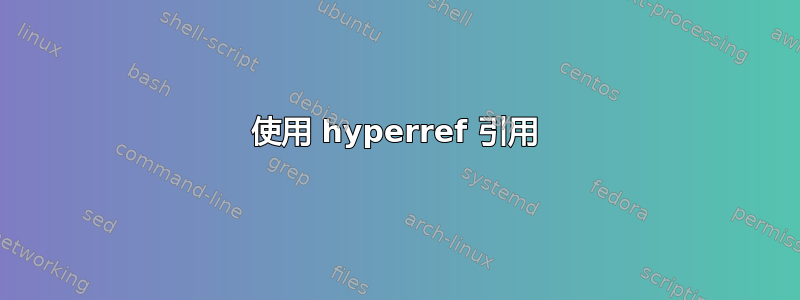
我发现这回答使用“hyperref”引用。我想保留这种特定的引用样式,但希望参考文献的编号为 1、2、...,而不是像输出中那样使用方括号中的文本。也就是说,输出显示“参考文献”列表以 [帖子] 开头,后跟参考文献的名称。但我希望它被编号。有什么方法可以实现它吗?这是我使用这种格式输入的文章的一部分:
\documentclass[12pt]{article}
\usepackage[margin=1in]{geometry}
\usepackage{authblk, amssymb, setspace}
\usepackage{amsmath, enumitem, pst-node, array, float, caption, graphicx}
\usepackage{cite}
\renewcommand\citeleft{}
\renewcommand\citeright{}
\usepackage[colorlinks,citecolor=blue]{hyperref}
\doublespacing
\date{}
\title{\textbf{Post-quantum Cryptography using Entropic Quasigroups}}
\begin{document}
\section*{\centerline{1. Introduction}}\setcounter{section}{1}
It is a never-ending race to be one step ahead of adversaries in the pursuit of secure cryptographic algorithms and protocols.
As quantum computing gains momentum, a number of cryptographic protocols relying on the mathematical concepts of number theory, group and field theory and Boolean algebra have become vulnerable to attacks.
The focus is therefore shifting towards non-associative and non-commutative algebraic structures that may be able to withstand these attacks.
In this paper, we discuss one such non-commutative and non-associative algebraic structure known as \emph{entropic} groupoids given in Gligoroski (\cite{Gligoroski1}) satisfying the \emph{palintropic} property which is also a quasigroup.
Quasigroups have the ability to accommodate many cryptographically suitable properties (non-associativity, polynomial completeness to name a few) and especially, the number of possible quasigroups increases exponentially with an increase in their order, thus providing ample options to a cryptographer to choose the suitable ones for a particular cryptographic scheme (Schafer \cite{Schafer}). Quasigroup operations as in Markovski (\cite{Markovski}) are also useful in defining easy, fast and secure cryptographic functions.\\
\begin{thebibliography}{23}
\bibitem[2021a]{Gligoroski1}
\textbf{D. Gligoroski}, {\em Entropoid based cryptography.}, IACR Cryptology ePrint Archive 2021/469, (2021).
\bibitem[2015]{Markovski}
\textbf{S. Markovski}, {\em Design of crypto primitives based on quasigroups.}, Quasigroups Related Systems, \textbf{23} (2015), $41 - 90$.
\bibitem[2008]{Schafer}
\textbf{R. D. Schafer}, {\em An introduction to nonassociative algebras.}, The Project Gutenberg EBook (2008), EBook $\#$25156.
\end{thebibliography}
\end{document}
答案1
这是一个非标准样式请求,因此不是开箱即用的支持。
您可以通过深入了解 latex 的内部结构及其修改来调整这些内容hyperref。标准\bibitem[pkey]{key}entry会生成一个参考书目项目,该项目的标签由 给出,并pkey具有特定的样式。在您的例子中,您只想pkey在文本中使用 ,并希望在参考书目中忽略它。为此,我们需要重新定义生成参考书目条目的内部命令,即\@lbibitem。我们还希望调整由 控制的数字标签的打印样式\@biblabel。@这两个名称中的 表示这些是内部命令。以下是产生您风格的修订定义
\makeatletter
\def\@lbibitem[#1]#2{%
\@skiphyperreftrue\H@item\@skiphyperreffalse
\Hy@raisedlink{%
\hyper@anchorstart{cite.#2\@extra@b@citeb}\relax\hyper@anchorend
}%
\if@filesw
{\let\protect\noexpand
\immediate
\write\@auxout{\string\bibcite{#2}{#1}}}\fi\ignorespaces}
\def\@biblabel#1{#1.}
\makeatother
将其放入文档中可得到
\documentclass[12pt]{article}
\usepackage[margin=1in]{geometry}
\usepackage{authblk, amssymb, setspace}
\usepackage{amsmath, enumitem, pst-node, array, float, caption, graphicx}
\usepackage[center]{titlesec}
\usepackage[noadjust]{cite}
\usepackage[colorlinks,citecolor=blue]{hyperref}
\renewcommand\citeleft{}
\renewcommand\citeright{}
\titlelabel{\thetitle.\space}
\makeatletter
\def\@lbibitem[#1]#2{%
\@skiphyperreftrue\H@item\@skiphyperreffalse
\Hy@raisedlink{%
\hyper@anchorstart{cite.#2\@extra@b@citeb}\relax\hyper@anchorend
}%
\if@filesw
{\let\protect\noexpand
\immediate
\write\@auxout{\string\bibcite{#2}{#1}}}\fi\ignorespaces}
\def\@biblabel#1{#1.}
\makeatother
\doublespacing
\date{}
\title{Post-quantum Cryptography using Entropic Quasigroups}
\author{}
\begin{document}
\maketitle
\section{Introduction}
It is a never-ending race to be one step ahead of adversaries in the
pursuit of secure cryptographic algorithms and protocols.
As quantum computing gains momentum, a number of cryptographic
protocols relying on the mathematical concepts of number theory, group
and field theory and Boolean algebra have become vulnerable to
attacks.
The focus is therefore shifting towards non-associative and
non-commutative algebraic structures that may be able to withstand
these attacks.
In this paper, we discuss one such non-commutative and non-associative
algebraic structure known as \emph{entropic} groupoids given in
Gligoroski (\cite{Gligoroski1}) satisfying the \emph{palintropic}
property which is also a quasigroup.
Quasigroups have the ability to accommodate many cryptographically
suitable properties (non-associativity, polynomial completeness to
name a few) and especially, the number of possible quasigroups
increases exponentially with an increase in their order, thus
providing ample options to a cryptographer to choose the suitable ones
for a particular cryptographic scheme (Schafer
\cite{Schafer}). Quasigroup operations as in Markovski
(\cite{Markovski}) are also useful in defining easy, fast and secure
cryptographic functions.
\begin{thebibliography}{23}
\bibitem[2021a]{Gligoroski1} \textbf{D. Gligoroski}, \emph{Entropoid
based cryptography}, IACR Cryptology ePrint Archive 2021/469,
(2021).
\bibitem[2015]{Markovski} \textbf{S. Markovski}, \emph{Design of crypto
primitives based on quasigroups}, Quasigroups Related Systems,
\textbf{23} (2015), 41--90.
\bibitem[2008]{Schafer} \textbf{R. D. Schafer}, \emph{An introduction
to nonassociative algebras}, The Project Gutenberg EBook (2008),
EBook \#25156.
\end{thebibliography}
\end{document}
请注意,我已将选项添加noadjust到cite包中,以删除不需要的空格。我还调整了代码的许多其他方面,以使其更符合标准 LaTeX 实践。





